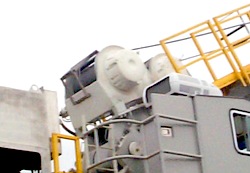
The two LANTEC winches provide lots of lifting capacity in a compact unit.
The two compact winches sit comfortably at the base of the 100-foot crane
boom.
|
|
British Petroleum didn’t become one of the world’s most successful oil companies by making wrong decisions. When it came time to select cranes for their offshore natural gas platform in Trinidad and Tobago, BP specified Allied Marine Crane.
Similarly, when it came time for crane engineer Igor Kormishkin to select the winches for these cranes, he specified Allied's LANTEC winch.
British Petroleum Trinidad and Tobago (BP T&T) is developing a $600 million project, known as Kapok, to tap vast reserves of natural gas under the Caribbean Sea. The natural gas will be delivered from the new platform to a new central processing unit at Atlantic LNG, Trinidad’s major LNG plant.
Kellogg Brown & Root, of Houston, Texas, performed design engineering. J. Ray McDermott, Inc., Morgan City, Louisiana, is building the platform. McDermott will mount the cranes onto the platform prior to transport to the well field.
The two identical cranes will serve as the production and maintenance cranes for the “Kapok” and “Cassia B” platforms. They will be used primarily for swapping equipment and for unloading supplies from a supply vessel.
|
|
These cranes are BP’s first electrohydraulic cranes, using electric power to drive the hydraulic pumps. The cranes are rated at 200 HP. As part of BP’s commitment to reducing emissions from its facilities, they are switching to electrical power as much as possible.
The crane has a 100-foot boom, to provide long reach capability, yet is rated at 75 tons at a 10-foot lifting radius. To provide for both rapid lifting of small loads and a heavy lift capability, the crane uses two winches—a LANTEC 542-133 with 1-inch line, and a LANTEC 201-121 with 3/4-inch line. The LANTEC 542 winch will use 4-part line, to provide a hook speed of 60 ft/min. The LANTEC 201, with single-part line, delivers 150 ft/min hook speed.
The LANTEC winch is a compact unit that fits comfortably atop
the crane boom. The smooth, clean exterior resists accumulation of seawater,
thereby minimizing corrosion.
Over the years, the LANTEC winch has developed the reputation for being “bulletproof,”
totally reliable and dependable. For a key component of an offshore oilrig,
that's probably the most desirable attribute a piece of machinery should
possess.
The LANTEC winches use Rexroth piston motors. These motors are able to develop higher RPM than the standard gear motor, and they operate at higher hydraulic efficiency. This helps to reduce the horsepower requirements.
The cranes were required to meet API certification standards. As a result, the LANTEC winches were built and tested to satisfy the applicable requirements. The API load rating on the main winch is over 24,000 lbs.
If the LANTEC winch can handle this kind of demanding application, you know it can handle just about anything. It’s built and tested to the same high standards as the towing winches used on crawler tractors—built tough, built to last.